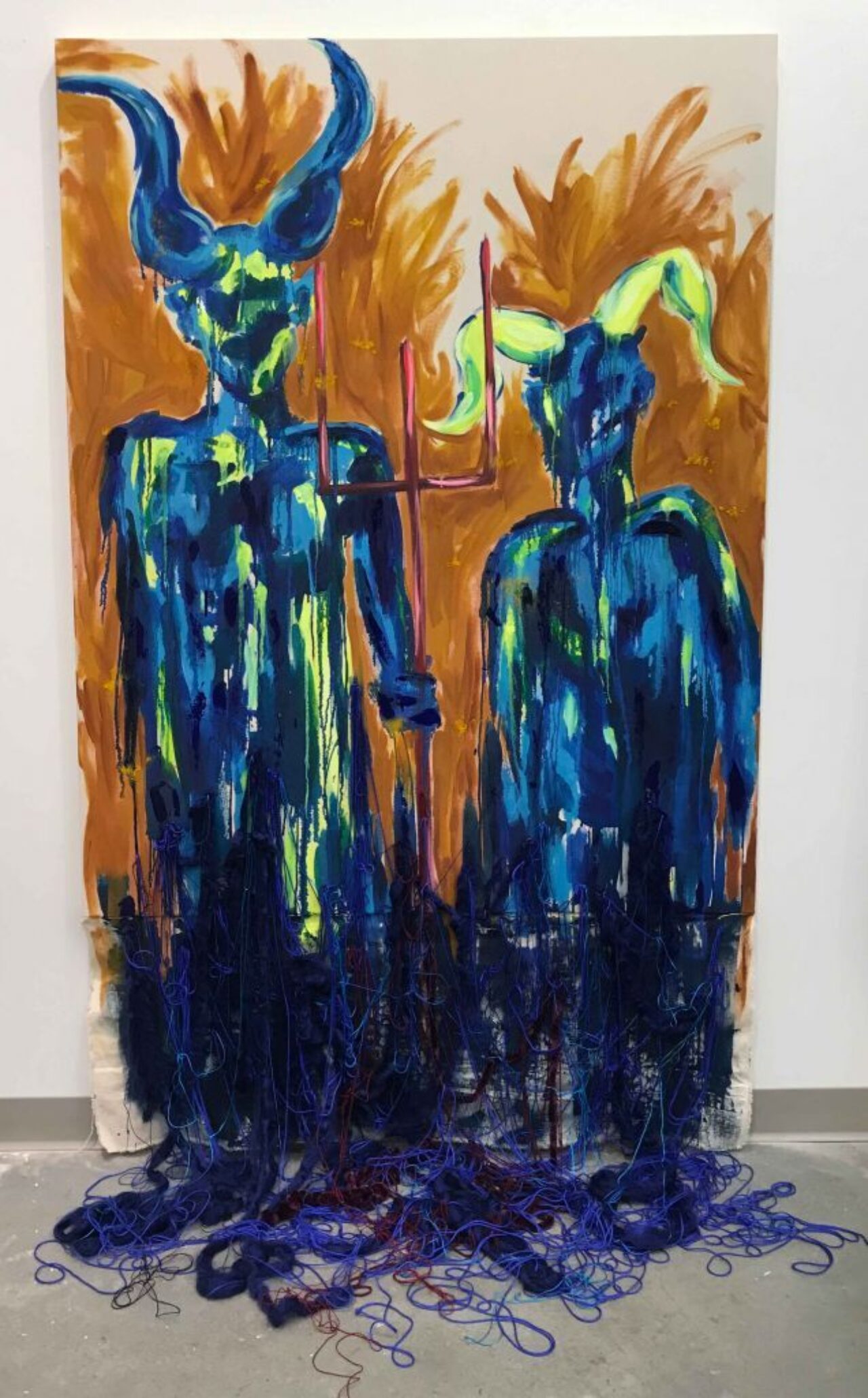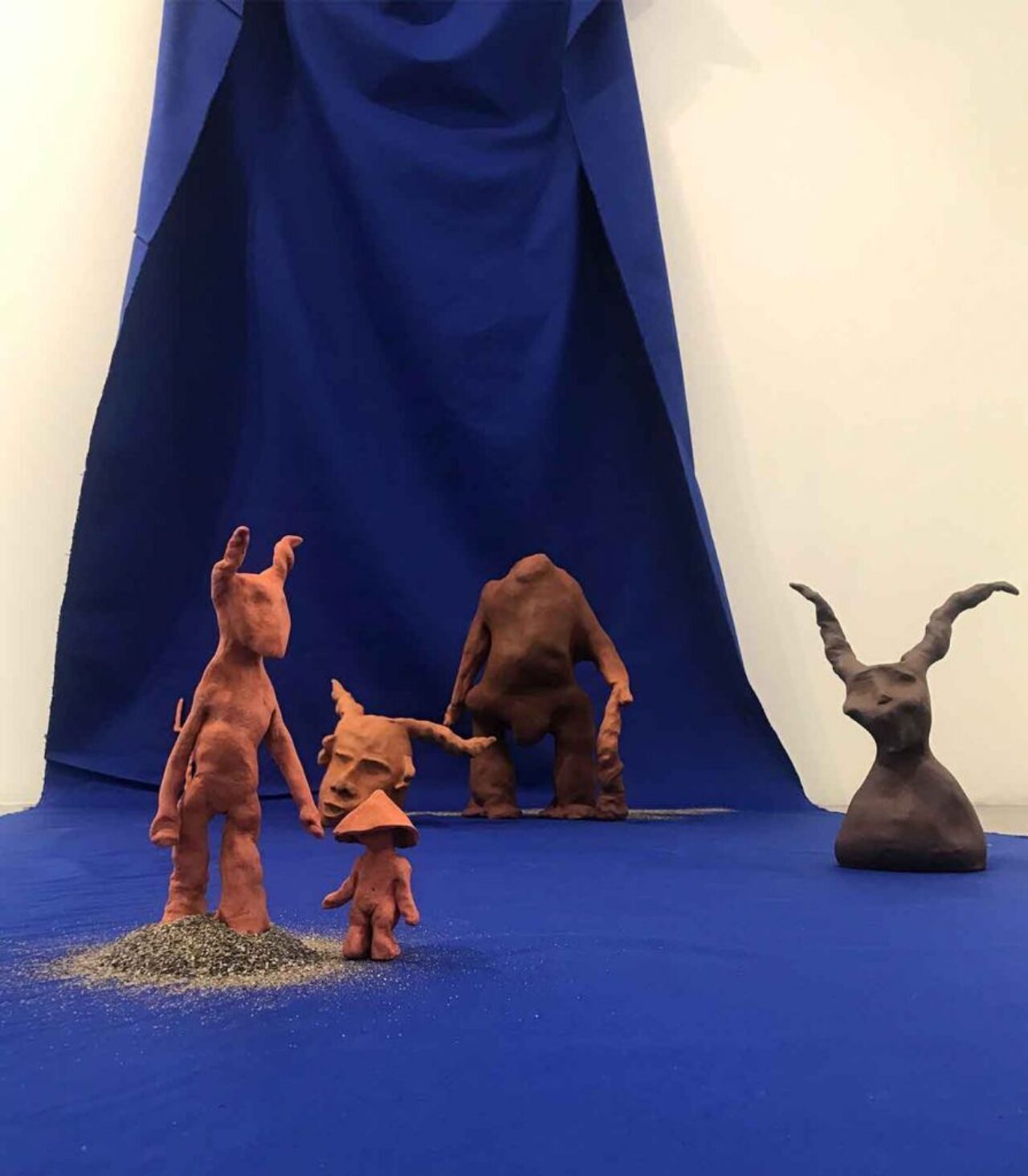Exploring Colonialism, Displacement and Cultural Fracture with Vivien Armour

Detail of Vivien Armour's Blue Boys (2019). (Image courtesy Vivien Armour)
Posted on | Updated
The 2020 grad is a multidisciplinary artist from Trinidad & Tobago who explores her relationship to her childhood home and the complex multicultural history.
Having grown up in the Caribbean as well as Europe and North America, Vivien Armour’s work investigates her feelings of displacement and cultural fracture with the relationships between culture, race and geopolitical influences on identity.
Vivien’s expressive paintings and sculptures showcase her interest in the festivals, folklores and hybrid cultures of Trinidad & Tobago while addressing how the history of slavery, indentured labour and colonialism in the Caribbean are both critiqued and celebrated through a myriad of cultural expressions.
Blue Boys depicts a pair of Blue Devils from the history of Traditional Mas in Trinidad. Various blues are laid over acid yellow, both playful and jarring.
The Traditional Mas has a myriad of characters to choose from. The festival is part satire and part celebration, exploring the culture’s ties to slavery and colonialism.

Blue Boys (2019) by Vivien Amour. 72" x 96" (approx.) Acrylic, oil, curry, turmeric yarn and thread on raw canvas. This painting depicts a pair of Blue Devils from the history of Traditional Mas in Trinidad. (Image courtesy Vivien Armour)
“There are many iterations of Devil Mas, as it is called, the oldest being the Jab Molassie,” said Vivien. “Jab Molassie is a representation of the slaves who covered themselves in molasses and other plantation goods like chocolate and wood ash as a part of their jubilation upon celebrating their emancipation.”
In Trinidad & Tobago, histories are passed down through oral traditions and through song. The Traditional Mas evolved into Carnival. It’s suspected that the Blue Devils were born from the incorporation of East Indian festivals.
“After the abolition of slavery there were a number of indentured labor programs bringing in workers from India and China,” said Vivien.
“With the Indian Indentured Laborers came their customs, traditions, religion and festivals, which were slowly incorporated into our own, creating hybrid customs and festivals.”
Vivien says that the blue pigment was adopted and blended in to the characters of Trinidad & Tobago’s festivals, something she learned through the oral histories.
The artist further explains that she situates her work in a liminal space of belonging and not belonging, exploring notions of personhood, alien-ness, Indigeneity, post-colonial trauma, cultural erasure, ethnic hybridity, bodily autonomy and sexuality.
“When representing the history of slavery, indentured labour, colonialism and identity in my work, I’ve lately been gravitating toward the Douens, which are depicted in my ceramic sculptures,” said Vivien. “Douens are faceless and genderless children with backward feet that are explained to be the spirits of children who died before being baptized, cursed to roam the forests in purgatory.”

Devils & Douens (2020) by Vivien Armour. Assortment of ceramic sculptures, unglazed in different natural clay bodies, depicting figures from folklore from Trinidad. (Image courtesy Vivien Armour)
Emphasizing that this folk tale was used to scare families into conforming to Christianity during Spanish Colonialism, the artist shares that it is something that is upheld today.
“To me, these misanthropic creatures hold a lot of memory of having to lie about my religion in order to get an education growing up when there was very little separation of church and state at the time,” explains Vivien. “They symbolize a fantasy of not belonging and fractured identity, neither here nor there, which I resonate with having moved from place to place, culture to culture, constantly being made to adopt new masks to fit in.”
Often incorporating the Devils and the practice of Mud Masking in her work, Vivien draws parallels between the festivals and the visceral and cathartic energy in her work.
An example of Mud Masking is her piece Dutty Mas in which she painted over oils with clay. “A derivative of the Jab Molassie, there is practice that marks the opening of Carnival called J’ouvert where participants flood the streets covering themselves in mud, paint, coloured pigment and chocolate and dance to traditional steel drum music,” said Vivien.
“While practicing art here in Vancouver, it has been important for me to share these histories and stories both to reclaim space for myself within a white North American context but also to teach a white North American audience about my history and my people,” said Vivien. “Now that I am moving back to Trinidad to practice there, I look forward to diving deeper into our Indigenous history and learning for myself so that I may bring even more traditional Caribbean history to my work.”